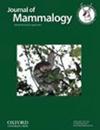固着菌和类杆菌对雌性冬眠者的体重增加变化做出了贡献
IF 1.5
3区 生物学
Q2 ZOOLOGY
引用次数: 0
摘要
获得身体状况是一项重要的生活史挑战,直接影响个体的体质,对冬眠动物尤为重要,因为维持足够的体脂和体质量对其生存至关重要。宿主相关微生物在动物生理和行为中发挥着重要作用,这一点已得到充分证明。最近的研究表明,肠道微生物与脂肪积累和肥胖有关,尤其是固着菌门和类杆菌门。大多数微生物组研究的重点是人类健康,或将实验室饲养的动物作为模型系统。然而,这些微生物很可能对野生种群的个体适应性非常重要,并为野生动物的适应性和生存提供了潜在的机理启示。在这里,我们通过分析在 5 个夏季活动季节中收集的 207 份粪便样本,检验了在黄腹旱獭(Marmota flaviventer)野生种群中,固缩菌纲和类杆菌纲中的共生微生物是否与夏季体重增加有关。结果表明,体重增加率越高的旱獭,其固着菌的相对丰度越高。相比之下,质量增加率较低的旱獭体内的类杆菌相对丰度较高,但只有生活在较恶劣环境中的旱獭才会出现这种情况。在科一级也发现了类似的模式,在较恶劣的环境中,固缩菌属的反刍球菌科(Ruminococcaceae)与较高的增重率相关,而拟杆菌科(Muribaculaceae)与较低的增重率相关。这些结果虽然具有相关性,但突出了共生肠道微生物群对野外增重的潜在重要性--在许多分类群中,这种特性与生存和适应能力有关。本文章由计算机程序翻译,如有差异,请以英文原文为准。
Firmicutes and Bacteroidetes contribute to mass gain variation in female obligate hibernators
Obtaining body condition is an important life history challenge that directly impacts individual fitness and is particularly important for hibernating animals, whose maintenance of adequate body fat and mass is essential for survival. It is well-documented that host-associated microorganisms play a vital role in animal physiology and behavior. Recent work demonstrates that gut microbes are associated with fat accumulation and obesity, particularly the phyla Firmicutes and Bacteroidetes. The focus of most microbiome studies has been on human health or involved lab-reared animals used as a model system. However, these microbes likely are important for individual fitness in wild populations and provide potential mechanistic insights into the adaptability and survival of wildlife. Here we tested whether symbiotic microorganisms within the phyla of Firmicutes and Bacteroidetes were associated with summer mass gain in an exceptionally well-studied wild population of yellow-bellied marmots (Marmota flaviventer) by analyzing 207 fecal samples collected over 5 summer active seasons. Results showed that marmots with higher mass gain rates had a greater relative abundance of Firmicutes. In contrast, a higher relative abundance of Bacteroidetes was associated with lower mass gain rates, but only for marmots living in harsher environments. Similar patterns were found at the family level where Ruminococcaceae, a member of Firmicutes, was associated with higher mass gain rates, and Muribaculaceae, a member of Bacteroidetes, was associated with lower mass gain rates in harsher environments. Although correlative, these results highlight the potential importance of symbiotic gut microbiota to mass gain in the wild—a trait associated with survival and fitness in many taxonomic groups.
求助全文
通过发布文献求助,成功后即可免费获取论文全文。
去求助
来源期刊

Journal of Mammalogy
生物-动物学
CiteScore
3.30
自引率
5.90%
发文量
106
审稿时长
4-8 weeks
期刊介绍:
Papers are published on mammalian behavior, conservation, ecology, genetics, morphology, physiology, and taxonomy.
 求助内容:
求助内容: 应助结果提醒方式:
应助结果提醒方式:


